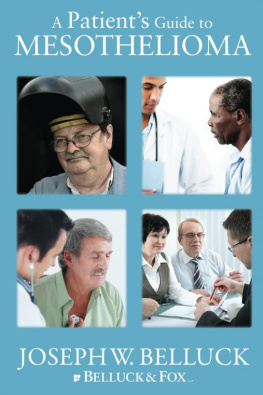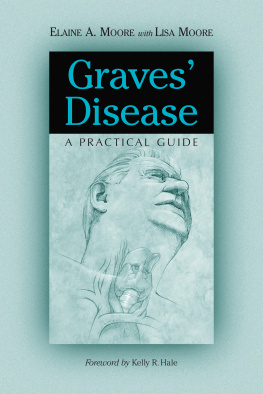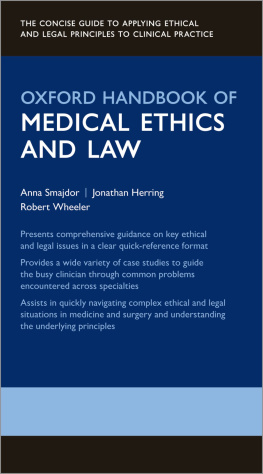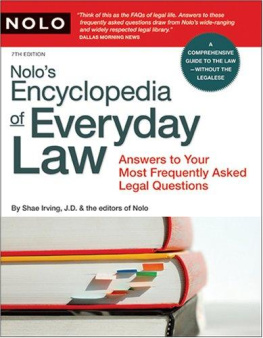A Patients Guide to Mesothelioma
Copyright 2013 ByJoseph W. Belluck
Belluck & Fox, LLP
Smashwords Edition
A Patients Guide to Mesothelioma
Joseph W. Belluck
Belluck & Fox, LLP
546 Fifth Ave, 4th Floor
New York, NY 10036
Toll-free: 877-637-6843
Visit our websites:
www.belluckfox.com
www.mesotheliomahelp.net
Joseph W. Belluck, 2013
All rights reserved. No part of this publication may be reproduced,in whole or in part, without the express written consent of thepublisher.
Belluck, Joseph W.
A Patients Guide to Mesothelioma
Health & Fitness / Diseases / Cancer
Table of Contents
Introduction: How to Use This Book
Chapter 1: Understanding What MesotheliomaIs
Whos at Risk
How Your Respiratory System Works
Types of Mesothelioma
Mesothelioma Stages and Cell Types
Other Asbestos-Related Lung Diseases
Chapter 2: What Is Asbestos?
Types of Asbestos and Their Uses
Discovery of the Health Hazards ofAsbestos
Chapter 3: Diagnosing Mesothelioma
Mesothelioma Symptoms
Diagnosing Mesothelioma
Imaging Tests
Taking Biopsies
Chapter 4: Treating Mesothelioma
Surgery
Chemotherapy
Radiation Therapy
New Therapies
Clinical Trials
Finding a Doctor and Treatment Center
Chapter 5: Living With Mesothelioma
Taking Care of Your Physical Health
Dealing with the Emotional Impact
Considering Hospice Care
Chapter 6: Exploring Your Legal Rights andOptions
Filing a Timely Claim
Choosing an Attorney
Checking Out Financial AssistanceOptions
Chapter 7: How the Claims Process Works
Stages of a Lawsuit
Chapter 8: Other Legal Considerations
Advance Health Care Directives
Wills
Other Important Papers
Glossary
Appendix A: Mesothelioma Specialists
Appendix B: Personal Medical Journal
Appendix C: Mesothelioma Treatment Record
Appendix D: Records
About Belluck & Fox
Introduction
How to Use This Book
Families can have a tough time coping withmesothelioma and other asbestos-related illnesses. Because thesediseases are relatively rare, you may feel isolated. And your legaloptions can be complex and confusing.
We have produced this handbook to help answeryour questions about the medical and legal aspects of mesotheliomaand asbestos-related diseases. The medical and legal aspects ofmesothelioma are connected because mesothelioma is an entirelypreventable environmental illness caused only by exposure toasbestos.
Written in plain English, witheasy-to-understand definitions of technical terms right in thetext, this book is designed to serve two purposes: Its a referencefor you to turn to with your medical and legal questions, as wellas a personal journal for you to track your treatments and otherimportant information in one convenient place.
The book is divided into three sections.Chapters 1 through 5 cover the medical side of mesothelioma andasbestos-related disease. Chapters 6 through 8 help you navigateand understand your legal options if you (or a loved one) sufferfrom the effects of asbestos exposure. In the back of the book,youll find a glossary, a list of doctors and treatment centersthat specialize in mesothelioma and related diseases, and usefulcharts and checklists for keeping track of your symptoms,treatments, and important documents and records.
You dont have to read this book cover-to-cover,or even in order. Each chapter is written so that you can turndirectly to the information thats most important to you.
Cross-references to other chapters are provided so you can easilyfind answers to your questions. And each chapter includes a page ortwo for you to make your own notes.
Mesothelioma is a relatively rare but seriousillness, and its natural to feel overwhelmed when it strikes closeto home. But you dont have to face this life-changing diagnosis or its consequences alone. Use this book to get the informationyou need to make informed choices about your medical care and legalrights. And visit us online at www.mesotheliomahelp.net for additionalassistance.
Chapter 1
Understanding What Mesothelioma Is
Mesothelioma is a rare form of cancer thatarises in the mesothelium , a thinmembrane that protects your internal organs and allows them to movefreely without damage-causing friction. You have several of thesemembranes in your body: the pleura surround the lungs; the peritoneum protects your abdominal cavity (stomach, intestines, and otherorgans); and the pericardium envelops your heart.
Mesothelioma can occur in any of thesemembranes, but pleural mesothelioma is by far the most common,accounting for about 70 percent of all mesothelioma cases. Althoughsome people may have a genetic predisposition for developingmesothelioma, nearly all cases arise from exposure to asbestos. Mentypically are at greater risk than women, but women also get thisdisease.
This chapter provides an overview ofmesothelioma, starting with a look at whos at risk for developingmesothelioma, how your respiratory system works and howmesothelioma affects your body. Look for cross-references to otherchapters for more detailed information.
Whos at Risk
Between 2,500 and 3,000 new cases ofmesothelioma are diagnosed each year. Anyone who has been exposedto asbestos is at risk for developing mesothelioma, and, althoughyour risk increases with the length of time you were exposed toasbestos, even small exposures to asbestos can causemesothelioma.
Ironically, your risk also increases with thelength of time that elapses after your exposure to asbestos.Mesothelioma has a very long latencyperiod that is, the period between exposure toasbestos and the onset of symptoms of the disease.
Mesothelioma typically doesnt appear until at least a decade afterasbestos exposure; in some cases, the latency period has been 50years or longer.
Sometimes, mesothelioma results from exposure tonaturally occurring asbestos, but the most common causes areexposure to asbestos in the workplace or from products used in thehome (see Chapter 2 for examples of such products). Spouses andfamily members of workers also may have been exposed to asbestosdust and fibers from the clothing the workers wore home from thejob site.
Here are some quick facts about mesothelioma andrisk factors:
Men are more commonlydiagnosed than women, because men more typically worked in jobswhere they were exposed to asbestos. These high-risk jobs includeelectricians, shipyard workers, factory workers, pipefitters, oilrefinery workers, auto mechanics, machinists, and steel workers.(See Chapter 2 for more on how asbestos was used and the mostdangerous jobs relating to asbestos exposure.) Older men accountfor more than 90 percent of all new mesothelioma diagnoses eachyear. Although no one knows exactly why, Caucasian men arestatistically more likely to develop the disease thanAfrican-American or Hispanic men.
Women who worked in factorieshad increased direct exposure to asbestos and are more likely to bediagnosed with mesothelioma later in life.
Women whose husbands,fathers, or other household members worked in high-exposure jobsalso are at risk of developing mesothelioma from secondary exposureto the asbestos dust and fibers on work clothes. Children in thesehomes also are at risk from secondary exposure.
People who usedasbestos-containing products in their homes are at increased riskof developing mesothelioma.
Because of mesotheliomaslong latency period, people over the age of 50 are more likely tobe diagnosed with the disease. Most mesothelioma diagnoses come inpatients between the ages of 50 and 70; those who are diagnosedearlier may have a better chance of long-term survival.









